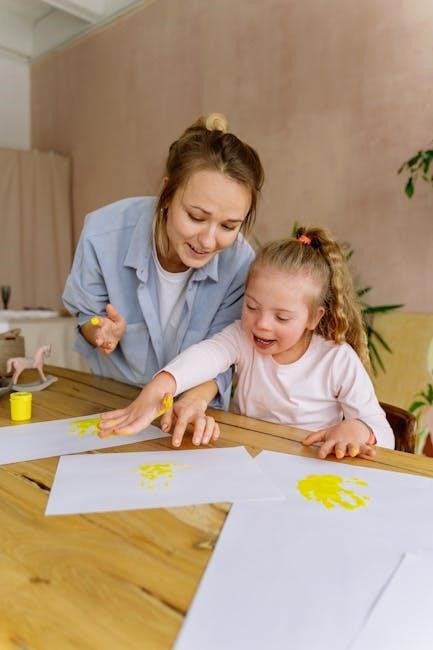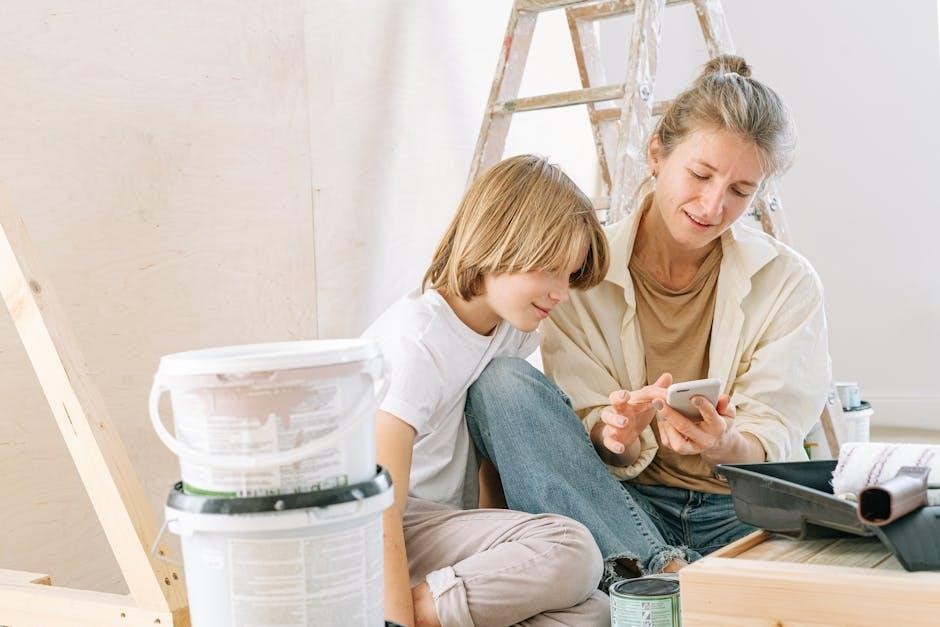Family therapy activities are designed to improve communication, trust, and emotional bonds within families. They include exercises like active listening, trust-building games, and creative expression to foster understanding and resolve conflicts effectively.
Definition and Purpose of Family Therapy Activities
Family therapy activities are structured exercises designed to enhance communication, resolve conflicts, and strengthen emotional bonds within families. These activities are typically led by a therapist and involve all family members, creating a safe space for expression and understanding. The primary purpose is to address specific issues, improve interpersonal dynamics, and foster positive behavioral changes. By engaging in these activities, families can gain insights into their interactions and develop healthier communication patterns. Activities often include trust-building exercises, role-playing, and creative approaches like art or play therapy. The goal is to empower families to navigate challenges collaboratively, promoting a supportive and cohesive family environment. These exercises are adaptable to various family dynamics and age groups, making them a versatile tool in therapy settings.
Importance of Communication in Family Dynamics
Effective communication is the cornerstone of healthy family dynamics, fostering understanding and emotional connection among members. It allows individuals to express their thoughts, feelings, and needs clearly, reducing misunderstandings and conflicts. Open communication helps build trust, empathy, and mutual respect, which are essential for resolving disagreements constructively. When communication breaks down, families may experience increased tension, emotional distance, and unresolved issues. Active listening, using “I” statements, and encouraging honest dialogue are key strategies to improve communication. By prioritizing communication, families can create a supportive environment where each member feels valued and heard. This, in turn, strengthens family bonds and equips members with the skills to navigate life’s challenges together. Communication is not just about speaking but also about understanding and being understood, making it a vital component of family therapy activities.
Benefits of Structured Activities in Family Therapy
Structured activities in family therapy provide a safe and guided environment for families to interact meaningfully. These activities are designed to address specific challenges, such as communication barriers, trust issues, and conflict resolution. By engaging in these exercises, family members can express emotions, share perspectives, and develop healthier interaction patterns. Structured activities ensure active participation from all members, fostering collaboration and mutual understanding. They also help families identify and address underlying issues, promoting positive behavioral changes. For example, activities like the Family Conversation Jar or Communication Boulders encourage open dialogue and empathy. These exercises are tailored to the family’s needs, making them highly effective in strengthening relationships and improving communication. Over time, structured activities empower families to resolve conflicts constructively and build a stronger, more supportive family dynamic. They serve as a foundation for long-term communication improvement and emotional growth.

Foundational Communication Skills in Family Therapy
Active listening, “I” statements, and open dialogue are foundational communication skills in family therapy. These techniques foster emotional expression, reduce misunderstandings, and strengthen family bonds effectively.
Active Listening Exercises
Active listening exercises are crucial in family therapy to enhance communication. These exercises involve techniques like maintaining eye contact, nodding, and paraphrasing to ensure understanding. Families are encouraged to take turns speaking without interruptions, fostering a safe environment for expression. One effective activity is the “Listening Circle,” where each member shares their thoughts while others focus solely on listening. This practice helps reduce misunderstandings and builds empathy. Another exercise is “Reflective Listening,” where the listener repeats back what they heard to confirm understanding. Such exercises promote mutual respect and deepen emotional connections, making them a cornerstone of family therapy. By incorporating these activities, families can improve their ability to communicate effectively and resolve conflicts constructively. Regular practice of active listening strengthens relationships and fosters a supportive family environment.
Using “I” Statements to Express Emotions
Using “I” statements is a powerful tool in family therapy to enhance emotional expression and reduce conflict. These statements help individuals communicate their feelings without blaming others, fostering a non-defensive environment. For example, saying “I feel hurt when…” instead of “You always…” focuses on personal emotions rather than accusations. This approach encourages accountability and promotes understanding. Families can practice this technique through guided exercises, such as role-playing scenarios where members take turns expressing their emotions using “I” statements. This method not only clarifies individual perspectives but also strengthens empathy and mutual respect. Regular use of “I” statements can lead to more constructive conversations, addressing issues effectively while maintaining emotional connections. By incorporating this practice, families can navigate conflicts with greater ease and understanding, fostering healthier relationships. This communication strategy is a key component of many family therapy programs aimed at improving interpersonal dynamics.
Encouraging Open and Honest Dialogue
Creating an environment where family members feel safe to express themselves is crucial for fostering open dialogue. Family therapy activities often include structured exercises that encourage honesty and reduce fear of judgment. Techniques like active listening and empathy-building games help create a supportive atmosphere. For instance, activities such as “family conversation jars” or “communication boulders” provide prompts or challenges that guide meaningful discussions. These exercises help individuals articulate their thoughts and feelings clearly, ensuring all voices are heard. By promoting transparency and understanding, families can address underlying issues and build stronger relationships. Regular practice of these activities strengthens communication skills, leading to more harmonious interactions and better conflict resolution. Open dialogue is essential for emotional well-being and long-term family cohesion, making it a cornerstone of effective family therapy. These strategies empower families to communicate effectively and maintain healthy connections.

Activities to Build Trust and Empathy
Trust-building exercises and empathy-focused activities help families strengthen relationships by fostering mutual understanding and cooperation. These activities reduce conflict and promote emotional connection.
Trust-Building Exercises for Family Members
Trust-building exercises are essential for fostering a supportive family environment. Activities like sharing personal experiences, collaborative problem-solving, and empathy-focused games help family members connect deeply. For instance, drawing family dynamics or creating a “Communication Jar” encourages open dialogue and mutual understanding. These exercises promote honesty, reliability, and emotional closeness, which are vital for trust. By engaging in these structured activities, families can address past conflicts and strengthen their bond. Regular practice of these exercises ensures long-term trust and healthier relationships.
Empathy-Building Activities for Children and Adolescents
Empathy-building activities help children and adolescents understand and share the feelings of others. These exercises are crucial for fostering compassion and improving communication within families. Techniques such as role-playing, storytelling, and art-based projects allow young individuals to explore different perspectives. For example, drawing family dynamics or engaging in group discussions about emotions can deepen their understanding of others’ experiences. Play therapy is particularly effective, as it provides a safe space for children to express and process emotions. By participating in these activities, children develop the ability to empathize, which strengthens family bonds and promotes a supportive environment. Regular practice of empathy-building exercises ensures healthier relationships and better communication skills in the long term.
Group Activities to Foster Mutual Understanding
Group activities are essential for fostering mutual understanding among family members, helping them connect on a deeper level. One effective exercise is creating a family conversation jar, where everyone writes down topics or questions to discuss during meals or gatherings. This encourages open dialogue and ensures each person’s voice is heard. Another activity involves communication boulders, where participants share concerns or frustrations, promoting active listening and problem-solving together. Additionally, collaborative tasks like drawing family dynamics or role-playing scenarios allow members to visualize relationships and identify patterns. These exercises not only enhance empathy but also create a safe space for families to address conflicts and strengthen bonds. By engaging in such activities, families can cultivate a culture of understanding and cooperation, leading to healthier and more resilient relationships. Regular participation in these exercises fosters long-term communication improvement and emotional connection.

Creative Approaches to Family Communication
Creative methods like play therapy, art, and music enhance family communication, offering non-traditional ways to express emotions and foster connection. These approaches make therapy engaging and effective.
The Role of Play Therapy in Improving Communication
Play therapy is a powerful tool in family communication, allowing members to express emotions and resolve conflicts in a non-verbal, engaging manner. By using toys, games, or creative activities, families can explore feelings and dynamics in a safe, playful environment. This approach is particularly effective with children, helping them articulate thoughts they might struggle to express verbally. Play therapy fosters trust, empathy, and understanding, encouraging open dialogue and healthier interactions. Techniques like role-playing or drawing can reveal underlying issues and promote collaboration. The Essential Family Therapy Workbook emphasizes such activities, offering structured exercises to enhance connection and communication. Play therapy not only strengthens family bonds but also equips members with tools to navigate future challenges effectively. Its engaging nature makes it an invaluable method for improving communication across all age groups.
Art and Music as Therapeutic Communication Tools
Art and music are transformative tools in family therapy, offering non-verbal avenues for expression and connection. Through activities like drawing or creating music together, family members can convey emotions that are difficult to articulate verbally. These mediums foster empathy and understanding, helping individuals connect on a deeper level. Art therapy allows families to explore dynamics visually, while music encourages collaboration and emotional release. The Essential Family Therapy Workbook highlights such exercises, providing structured activities to enhance communication. These creative approaches not only bridge generational gaps but also create a safe space for dialogue, reducing tension and fostering mutual respect. By engaging in art and music, families can build stronger bonds and develop healthier communication patterns, leading to lasting positive change. These tools are particularly effective in reaching children and adolescents, who may find traditional talk therapy challenging.
Storytelling as a Means of Sharing Experiences
Storytelling is a powerful tool in family therapy, enabling members to share experiences and emotions in a meaningful way. By recounting personal narratives, families can foster empathy, understanding, and connection. This activity encourages open communication, helping individuals feel heard and validated. Storytelling can be verbal or non-verbal, such as through art or role-playing, making it accessible to all ages. It breaks down barriers and creates a safe space for dialogue, allowing families to address conflicts and strengthen bonds; The Essential Family Therapy Workbook highlights storytelling as a therapeutic approach to improve communication and emotional expression. This method not only enhances interpersonal understanding but also preserves family history and cultural values, making it a valuable component of family therapy. Through storytelling, families can build trust and develop healthier ways of interacting, leading to long-term positive change.

Practical Communication Exercises for Families
Practical communication exercises empower families to enhance interaction. Activities like Family Conversation Jar, Communication Boulders, and Drawing Family Dynamics foster openness, mutual understanding, and stronger family bonds.
Family Conversation Jar Activity
The Family Conversation Jar Activity is a simple yet effective tool to enhance communication within families. It involves creating a jar filled with conversation starters or questions that encourage open dialogue. Family members take turns drawing a prompt and sharing their thoughts or experiences. This activity fosters a safe and engaging environment for discussions, helping to break down barriers and deepen understanding. Examples of prompts might include, “What is something you appreciate about our family?” or “What is a challenge you’ve faced recently?” Regular use of the jar can help families address difficult topics, strengthen bonds, and create meaningful connections. It is particularly useful for families seeking to improve communication in a relaxed and interactive way. By encouraging active participation, the jar activity promotes empathy and mutual respect among all members.
Communication Boulders Exercise
The Communication Boulders Exercise is an interactive activity designed to help families identify and address obstacles that hinder effective communication. In this exercise, family members write down common communication challenges, such as misunderstandings or defensiveness, on small paper “boulders.” These are then shared in a group setting, fostering open dialogue about the issues. The activity encourages families to brainstorm strategies to overcome these challenges together. By acknowledging and addressing these “boulders,” families can create a more supportive and understanding environment. This exercise not only highlights the importance of communication but also empowers families to take proactive steps toward improving their interactions. It is a valuable tool for fostering collaboration and mutual respect, helping families navigate conflicts more effectively. Regular practice of this exercise can lead to lasting improvements in communication and overall family dynamics.
Drawing Family Dynamics for Insight
Drawing Family Dynamics for Insight is a creative activity where family members draw stick figures or diagrams representing their family structure and relationships. This exercise helps identify non-verbal communication patterns, power dynamics, and emotional connections. By visualizing their interactions, families can gain clarity on how they perceive each other and their roles within the family. This activity encourages participants to reflect on their relationships and express feelings that may be difficult to articulate verbally. It also serves as a therapeutic tool to uncover underlying tensions or misunderstandings. The drawings provide a safe space for open discussion, fostering empathy and understanding. This exercise is particularly effective for children or those who struggle with verbal communication, offering a unique way to explore and improve family dynamics. Regular use of this activity can lead to deeper insights and more meaningful interactions among family members.
Addressing Conflict and Improving Communication
This section explores strategies to resolve conflicts and enhance communication within families. Techniques include role-playing, active listening, and identifying barriers to foster understanding and reduce friction.
Conflict Resolution Strategies for Families
Conflict resolution is a critical aspect of family therapy, focusing on addressing disagreements constructively. Strategies include active listening, where each member acknowledges others’ perspectives, reducing defensiveness. Using “I” statements helps express feelings without blame, fostering a safer environment for dialogue. Role-playing exercises allow families to practice resolving conflicts in a controlled setting, promoting empathy and understanding. Identifying communication barriers, such as interrupting or dismissive language, helps families adapt healthier interaction patterns. These techniques, often outlined in resources like The Essential Family Therapy Workbook, provide structured approaches to managing disputes. By teaching families to address conflicts collaboratively, these strategies strengthen relationships and reduce tension, ensuring lasting communication improvement. Regular practice of these methods, supported by therapeutic guidance, can lead to more harmonious family dynamics.
Role-Playing to Practice Healthy Communication
Role-playing is a powerful tool in family therapy, enabling members to practice healthy communication in a safe environment. By simulating real-life scenarios, families can explore effective ways to express emotions and resolve conflicts. This method encourages active listening, empathy, and the use of “I” statements. Role-playing also helps identify and challenge negative communication patterns, such as interrupting or dismissive language. Guided by therapists, families can experiment with new interaction styles, fostering mutual understanding. Resources like The Essential Family Therapy Workbook offer structured exercises, making it easier to apply these techniques at home. Regular practice strengthens communication skills, leading to more harmonious family dynamics and improved conflict resolution. This approach is particularly beneficial for children and adolescents, helping them develop essential social and emotional skills. By reinforcing positive interactions, role-playing supports long-term communication improvement.
Identifying and Addressing Communication Barriers
Identifying and addressing communication barriers is crucial for improving family dynamics. Common barriers include emotional defensiveness, misunderstandings, and nonverbal cues that hinder expression. Therapists often use exercises like reflective listening and empathy-building activities to help families recognize these obstacles. Worksheets and handouts from resources like The Essential Family Therapy Workbook provide structured tools to explore these issues. By addressing these barriers, families can foster open dialogue and reduce conflict. Role-playing activities also help families practice navigating challenging conversations. Encouraging the use of “I” statements and active listening can break down defensive patterns. Additionally, science-based exercises focus on improving emotional awareness and clarity in communication. These strategies empower families to overcome barriers, leading to more meaningful and constructive interactions. Regular practice and follow-up activities reinforce these skills, ensuring long-term improvement in family communication.
Family Therapy Workbooks and Resources
Family therapy workbooks like The Essential Family Therapy Workbook offer practical tools and activities to enhance communication and foster positive behavior. They provide worksheets and exercises for meaningful discussions.
The Essential Family Therapy Workbook by Emily Simonian
The Essential Family Therapy Workbook by Emily Simonian, MA, LMFT, is a comprehensive resource designed to strengthen family bonds through structured activities and exercises. Focusing on key areas such as trust, support, kindness, and communication, this workbook provides practical tools for parents and caregivers to engage their children in meaningful discussions. Each lesson targets specific aspects of family dynamics, offering handouts and worksheets that promote positive behavior and emotional growth. The activities are tailored to foster open dialogue, helping families address conflicts and improve their relationship dynamics. By emphasizing skill-building and interactive exercises, this workbook creates a safe space for families to explore their emotions and develop healthier communication patterns. It serves as an invaluable guide for those seeking to enhance their family’s emotional well-being and resilience.
Worksheets and Handouts for Meaningful Discussions
Worksheets and handouts are invaluable tools in family therapy, providing structured activities to facilitate meaningful discussions and emotional expression. These resources often include exercises such as active listening practices, “I” statement worksheets, and empathy-building prompts. Designed to encourage openness and understanding, they help families address conflicts and strengthen their relationships. Many handouts focus on specific communication skills, such as identifying emotions, expressing needs, and resolving disagreements constructively. Additionally, creative activities like drawing family dynamics or writing letters can foster deeper connection and insight. These materials are often used in conjunction with workbooks like The Essential Family Therapy Workbook by Emily Simonian, offering practical and engaging ways to improve communication and foster a supportive family environment. By providing clear guidance and structure, worksheets and handouts empower families to navigate challenges and build stronger, more resilient relationships.
Science-Based Exercises for Communication Improvement
Science-based exercises for communication improvement are evidence-driven tools designed to enhance family interactions and emotional understanding. These exercises, often rooted in psychological research, focus on techniques like active listening, empathy-building, and constructive conflict resolution. Many resources, such as downloadable PDF guides, provide structured activities to practice these skills, ensuring measurable progress. For example, exercises that encourage the use of “I” statements help family members express emotions without blame, fostering a safer dialogue environment. Other activities, like role-playing or guided conversations, allow families to practice healthy communication in real-life scenarios. By incorporating these science-backed strategies, families can reduce misunderstandings, strengthen bonds, and develop resilience. These exercises are frequently recommended in therapeutic workbooks and are supported by clinical research, making them a reliable approach to improving communication and overall family dynamics.

Long-Term Strategies for Sustained Communication
Long-term strategies focus on maintaining healthy communication through consistent practices like scheduling family meetings and creating communication plans. These approaches ensure lasting improvements in family interactions and emotional bonds.
Creating a Family Communication Plan
A family communication plan is a structured approach to improving interactions by setting clear goals and guidelines. It involves active listening, expressing emotions with “I” statements, and dedicating time for open discussions. Families can use workbooks like The Essential Family Therapy Workbook to create personalized plans tailored to their needs. Regularly reviewing and adjusting the plan ensures it remains effective over time. This proactive strategy helps families address conflicts constructively and fosters a supportive environment for ongoing growth and understanding. By committing to a communication plan, families can build stronger relationships and maintain positive interactions long after therapy sessions end.
Scheduling Regular Family Meetings
Regular family meetings are a cornerstone of effective communication and relationship-building. These structured gatherings provide a dedicated space for open dialogue, helping families address issues, share experiences, and strengthen bonds. Meetings can be weekly or biweekly, depending on the family’s schedule, and should include activities like the Family Conversation Jar or Communication Boulders to encourage participation. Using resources such as The Essential Family Therapy Workbook or Worksheets and Handouts for Meaningful Discussions, families can incorporate guided exercises to foster empathy and understanding. Regular meetings also allow families to practice active listening, express emotions constructively, and resolve conflicts collaboratively; By prioritizing these sessions, families can create a routine that promotes consistent, meaningful communication and long-term relational growth.
Follow-Up Activities to Reinforce Communication Skills
Follow-up activities are essential for reinforcing communication skills learned during family therapy sessions. These exercises ensure that families continue practicing effective dialogue at home. One popular activity is the Family Conversation Jar, where members write down topics or questions and discuss them during meals. Another is the Communication Boulders Exercise, which helps identify and overcome barriers to clear expression. Families can also benefit from Science-Based Exercises found in resources like The Essential Family Therapy Workbook, which provide practical tools for ongoing improvement. Additionally, activities like Drawing Family Dynamics can offer visual insights into relational patterns, fostering deeper understanding. By consistently engaging in these follow-up activities, families can sustain and enhance their communication skills, leading to stronger, more resilient relationships over time.

